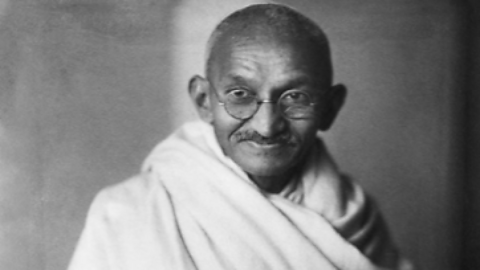
Key dates

1869 Mohandas Gandhi was born on October 2, in Porbandar, India.
1888 he studied law in London.
1893 he moved to South Africa to be a lawyer where he fought against the poor treatment of Indian immigrants.
1915 he returned to India. Many in India were growing angry at BritainÔÇÖs refusal to hand over meaningful power despite hundreds of thousands of Indians fighting to defend Britain during World War OneWorld War One, also known as the Great War, started in 1914 after the assassination of Archduke Franz Ferdinand of Austria. His murder catapulted into a war across Europe that lasted until 1918..
Initially Gandhi refused to get involved in politics, but the harsh methods used by the British authorities in India to keep control during World War 1 forced him to begin organising demonstrations, protests and boycotts.
1919, he launched an organised campaign of passive resistance in response to the passing of the Rowlatt ActThe Rowlatt Act was passed in 1919 and gave power to the police to arrest any person in India without any reason. The purpose of the Act was to curb the growing nationalist upsurge in the country..
Gandhi is now commonly known as ÔÇÿMahatma GandhiÔÇÖ.
ÔÇÿMahatmaÔÇÖ means ÔÇÿgreat soulÔÇÖ. He was given this name for all of the work he did to achieve Indian independence.

The Amritsar Massacre
On 13 April 1919, over 10,000 men, women and children gathered in an enclosed park in Amritsar, the Jallianwala Bagh, which had only one accessible exit.
The British authorities had given orders banning large gatherings of people, but not everyone had been made aware of this.
Some had gathered to celebrate a SikhSikhs are followers of the religion Sikhism. Sikhs believe in one God who guides and protects them. They believe everyone is equal before God. Sikhs believe that your actions are important and you should lead a good life. festival and others to protest British rule.
Without warning Colonel Dyer, a British general, had his troops block the only exit and shoot into the unarmed crowd.
Initially over 350 people were estimated killed, with over a thousand more injured. Historians now suggest that the death toll may have been higher.

Reports of the massacre spread across the world. Calls to give India its independence began to grow.
The massacre had a profound effect on Gandhi. He became convinced that India should accept nothing less than full independence.
Civil disobedience
Gandhi promoted non-violent civil disobedienceA form of peaceful protest in which someone refuses to obey certain laws because they believe they are unjust. campaigns in response to the Amritsar Massacre.
In 1921 he assumed leadership of the Indian National Congress (INC) and led several nationwide campaigns. These included easing poverty, building religious and ethnic peaceful harmony, expanding womenÔÇÖs rights and achieving self-rule.
He also became widely known for wearing a simple DhotiA garment worn by male Hindus, consisting of a piece of material tied around the waist and extending to cover most of the legs. and shawl. This was a way of identifying with IndiaÔÇÖs rural poor.

On March 10, 1922, Gandhi was arrested by the government on SeditionConduct or speech inciting people to rebel against the authority of a state or monarch. charges in Mumbai, known at the time as Bombay.
He was sentenced to six years in prison for his involvement in protesting the British colonial government in India. He served the jail sentence for two years before being released for medical reasons (he had appendicitis).
The Salt March

In 1930, Gandhi led a major protest, know as the Salt March.
The British had been taxing salt in India for decades but this hurt the poorest people most.
To show the world the injustice of British rule Gandhi marched to the coast with a growing number of people to symbolically collect salt from the sea without paying any tax to the British.
This tax made it difficult for poorer Indians to afford British salt, and it was also illegal for them to produce their own salt.
Anyone found to be making their own salt could be imprisoned for up to six months.
Gandhi and 78 other leaders marched 240 miles from the Sabarmati Ashram to Dandi.
They were joined by thousands of people who wanted to protest against British rule.
Gandhi led people to boycott British salt, and encouraged them to produce their own salt from sea water at Dandi.
After this protest, around 60,000 people were arrested, including Gandhi himself.
But the British government accepted that they had to consider some of GandhiÔÇÖs requests and invited him to London.
This was a significant turning point, because it showed that the British government was starting to seriously consider Indian independence.

Continuing the work for independence
Gandhi was imprisoned for two years during World War TwoA global conflict that lasted from 1939 to 1945.. He and other Indian leaders had demanded immediate independence as IndiaÔÇÖs price for aiding Britain in the war.
After his release from prison, he continued to campaign for IndiaÔÇÖs independence, which it achieved in 1947. IndiaÔÇÖs land was divided into two new countries: India and Pakistan.
India was torn by clashes between HindusHindus are people who believe in the religion called Hinduism. Central to Hinduism is the belief in a supreme God Brahman. Brahman is present everywhere and there is a part of Brahman in everyone. and MuslimsMuslims are followers of the religion Islam. Muslims believe there is one true God, called Allah (the Arabic word for God). In Arabic the word Islam means 'submission to the will of God'. before and after its division. On January 30, 1948, in the city of Delhi, Gandhi was shot and killed by a Hindu man.
Test your knowledge
More on Historical figures
Find out more by working through a topic
- count1 of 7

- count2 of 7

- count3 of 7

- count4 of 7
